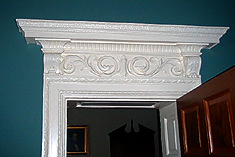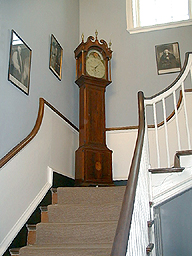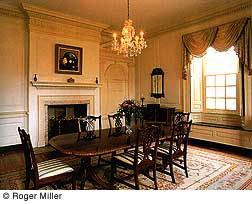As the Georgian style grew in popularity in British America, so did the size of the house, which meant that better building techniques were required. |
Intro 1 / Period Style 2 / Georgian History 3 / Shape 4 / Materials 5 / Structure 6 / Color 7 / Texture 8 / Size |
It is astounding that most of the homes built during this time were put together from representations in books and memories from foreign travel. Amazingly, these structures are very sturdy and solid. This is also due to the classical, square shape that has a solid foundation.
Ceilings - Ceilings of plaster were the most common. Later in the 18th century the elaborately molded, carved or decorated ceiling was popular. Often in the more formal rooms there was a central ornate medallion panel.
 Doors - Heavily molded
doors are a design of the 18th century Georgian style. Classical
surrounds were popular. These were made mostly of wood, and later
of stone or brick. The front door is important because it shows
off the fancy and elaborate center hall staircase.
Doors - Heavily molded
doors are a design of the 18th century Georgian style. Classical
surrounds were popular. These were made mostly of wood, and later
of stone or brick. The front door is important because it shows
off the fancy and elaborate center hall staircase.
Columns - These are visible in porticos, front door surrounds and fireplaces, but typically in the form of a classical pilaster.
Fireplaces - These
became smaller and focal points of the entertaining room. "An
important factor in this evolution was the separation of the
kitchen and the social rooms which left the fireplace unconstrained
by the needs of cooking". (The Elements of Style, pg. 121)
They were heavily decorated for the most part with carved wooded
ornaments, pilasters and classical surrounds. In the mid 1700's
the marble fireplace appeared.
Stairs - The central hall staircase is a key element of the Georgian style and classic central hall floor plan. The staircases tend to be open-string and have molded, turned and carved handrails and elaborate balusters. Often the sides of the staircases are paneled or have wainscoting and pilasters, and the side-ends are carved. There is often a second staircase used for more utilitarian purposes. The staircases are made of wood, as are the railings. Balustrades are also wooded.
Windows - By the 1730's the weighted wooden sash windows were starting to appear. Flat and dormer windows are part of this time period. Windows are more symmetric and in greater numbers. Internal shutters were also popular.
Walls - In general, the more formal the room the more decoration on the walls. From applied wood molding onto plaster sheath in imitation panels, to elaborate fretwork, skirting boards, and pilasters, ornamentation on the walls is a trade mark of the Georgian style.
Floors - Almost exclusively the floors were wood, generally pine planks, without stain or varnish. Painted floor cloths were very common. The use of finer rugs was rare and did not become more common until after the Revolutionary war.
 Furniture
- Built in furniture became more popular and was
prestigious. The cupboard, which housed the valuables such as
silver, tea, and cloth, was prominent. A more decorative carved
glass front corner cabinet visually showcased coveted items of
wealth. At the beginning of the 18th century furniture was rather
sparse. The improvements to and inventions of furniture really
proliferated with the emerging social class. Chairs were no longer
simply pushed against the wall but were designed for greater
seating comfort and lounging. Small tables for dining were replaced
with larger, many-leaved octagonals for sharing meals. Cupboards
were no longer just for storing precious items, they were needed
to display trinkets, dishes, food and libations. Armoires were
created to handle the increase in clothing needed for all the
refined activities.
Furniture
- Built in furniture became more popular and was
prestigious. The cupboard, which housed the valuables such as
silver, tea, and cloth, was prominent. A more decorative carved
glass front corner cabinet visually showcased coveted items of
wealth. At the beginning of the 18th century furniture was rather
sparse. The improvements to and inventions of furniture really
proliferated with the emerging social class. Chairs were no longer
simply pushed against the wall but were designed for greater
seating comfort and lounging. Small tables for dining were replaced
with larger, many-leaved octagonals for sharing meals. Cupboards
were no longer just for storing precious items, they were needed
to display trinkets, dishes, food and libations. Armoires were
created to handle the increase in clothing needed for all the
refined activities.
Previous / Intro /
1 / 2 / 3 /
4 / 5 / 6 /
7 / 8 / Next
Subscribe to our free and extremely informational newsletter. We would love to have your comments at: mail@designintuit.com
Welcome / What We're About / Focus on Annapolis / Marco Polo's Quest / Michelangelo's Den / Great Sites & Sources / Reading / Tiles & Textures / Tools & Terms / Contact Us
This site design and text © DesignIntuit, 2001